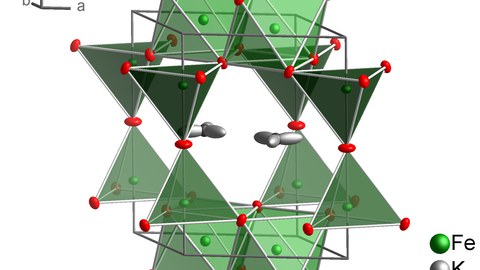Unkonventioneller Spinzustand eines Seltenerdeisenantimonids
Die ternäre, intermetallische Verbindung Pr3Fe3Sb7 zeigt ein ungewöhnliches magnetisches Verhalten, welches durch ein komplexes Zusammenspiel aus 3d und 4f Magnetismus des Übergangs- und des Seltenerdmetalls hervorgerufen wird. Die Züchtung mm-großer Kristalle gelang aus dem Bismut-Fluss und erlaubte die Untersuchung der magnetischen und elektrischen Eigenschaften. Durch eine Kombination aus magnetischen Messungen, Mößbauer Spektroskopie und Neutronenbeugung konnte die magnetische Struktur und die konkurrierenden Wechselwirkungen zweier Teilstrukturen aufgeklärt werden.
 © Falk Pabst
© Falk Pabst
Unkonventioneller Spinzustand eines Seltenerdeisenantimonids
Ein tiefgreifendes Verständnis der magnetischen Eigenschaften auf atomarer Ebene ist unerlässlich für das zielgerichtete Design neuer magnetische Materialien. Verbindungen aus Übergangs- und Seltenerdmetallen haben schon lange großes Interesse auf sich gezogen. Das Zusammenspiel aus itineranten (3d) und stark lokalisierten (4f) Elektronen ist der Ursprung für eine Vielzahl interessanter magnetischer Phänomene.
Als ein weiterer Vertreter derartiger Verbindungen wurde die ternäre, intermetallische Verbindung Pr3Fe3Sb7 erstmals beschrieben. Durch die Synthese im Bismut-Fluss gelang die Züchtung mm-großer, nadelartiger Kristalle, welche richtungsabhängige Messungen des magnetischen Verhaltens und der elektrischen Transporteigenschaften ermöglichte. Beim Kühlen in externen Feldern parallel zur Nadelachse (kristallographische c-Achse), trat eine starke Temperatur- und Feldabhängigkeit der Magnetisierung auf. Dabei konnte eine negative Magnetisierung (Magnetisierung entgegen der Feldrichtung) beobachtet werden, die nicht auf Supraleitung zurückzuführen ist.
Die Aufklärung des ungewöhnlichen Verhaltens gelang durch kombinierten Einsatz von magnetischen Messungen, Mößbauer Spektroskopie und Neutronenbeugung. Bereits die Kristallstruktur zeigt eine räumliche Trennung zweier Teilstrukturen aus Übergangs- und Seltenerdmetall. Die Untersuchungen zeigen eine konkurrierende Wechselwirkung dieser beiden Teilstrukturen bei tiefen Temperaturen. Dabei tritt eine entgegengesetzte Ausrichtung der Eisen- und Praseodym-Momente auf, welche aufgrund von magnetokristalliner Anisotropie zu einer makroskopisch negativen Magnetisierung führen kann. Bei Raumtemperatur ordnet lediglich die Eisen-Teilstruktur. Bereits diese weist ein komplexes magnetisches Verhalten auf, da zwei verschiedene Orientierungen der magnetischen Momente nebeneinander vorliegen. Mittels Mößbauer Spektroskopie konnte dieses Verhalten sowohl unter feldfreien Bedingungen als auch bei Messungen im externen Magnetfeld untersucht werden.
Die Untersuchung des komplexen Magnetismus in der ternären Verbindung leistet damit einen Beitrag für ein besseres Verständnis der magnetischer Interaktionen in intermetallischen Verbindungen. Potentielle praktische Anwendunggen sind im Bereich magnetischer Sensoren oder Schalter denkbar, welche von der starken Temperatur- und Feldabhängigkeit des Materials profitieren können.
Der Artikel kann in Advanced Materials eingesehen werden:




![[Cu2(bet)4(NTf2)2][NTf2]2](https://tu-dresden.de/mn/chemie/ac/ac2/ressourcen/bilder/forschungs-highlights/Fig1.png/@@images/02bc11b0-8187-45a9-ac14-5ba2204624c0.png)

![Clusterverbindung (Bi8)Tl[AlCl4]3](https://tu-dresden.de/mn/chemie/ac/ac2/ressourcen/bilder/forschungs-highlights/Knies-Low-Temperature-Ordering-in-the-Cluster-Compound-Bi8-Tl-AlCl4-3.jpg/@@images/d226d8ac-8ba3-4524-b9b7-dad74b83fdd3.jpeg)


